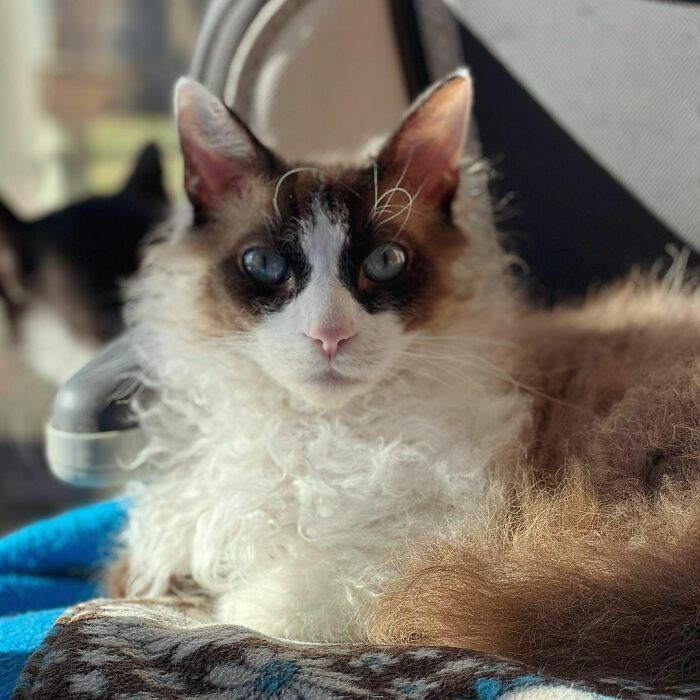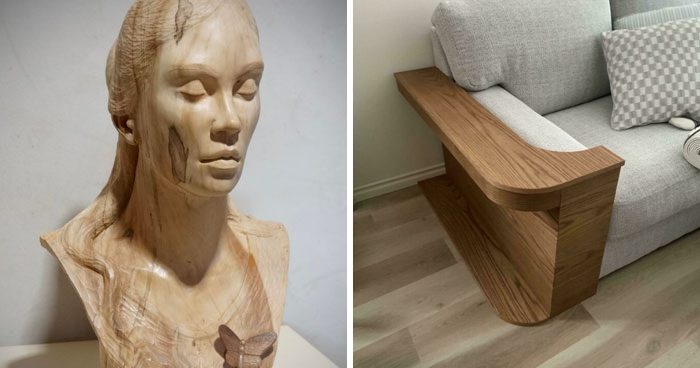Did you know that cats can also have permanent curly hairstyles? LaPerm breed has a recognizable curly coat. Besides this, this cat is very friendly and outgoing.
The information provided herein is for informational purposes only. Please refer to our disclaimer for more details..
LaPerm Cat Breed Characteristics
If you get this cat, you will surely enjoy a friendly but, at the same time, outgoing pet. Don’t be surprised if you get sudden cuddling in your lap. They enjoy spending time with their humans.
LaPerm enjoys being around people, so make sure you don’t leave it alone for too many hours.
The most interesting thing about this breed is its appearance. Long-haired cats have a curly coat, while short-haired LaPerms have a wavy coat.
All cat breeds might be a little bit “reserved” when it comes to kids. We all know that pets can get jealous easily, but this cat gets along with kids. But our advice is to keep them supervised, just in case.
History of the LaPerm
Everything about this breed started in the early 1980s thanks to Linda and Richard Koehl from The Dalles, Oregon. They had a cat named Speedy (a brown tabby barn cat) who gave birth to six kitties. The owners of Speedy noticed that one of the six kittens was completely bald, had a long body, and was small in size.
After a few weeks, this kitty grows a curly coat, and the story starts here. No wonder this cat was named Curly. When Curly matured reproductively, it gave birth to a litter of five tabby kittens, and a similar thing happened. The kittens from the new litter were bald but grew up a curly coat after a few weeks.
We assume that the social consciousness about sterilization was not that famous in the 80s, so cats related to Curly reproduced over the next decade and had random-bred litters. It passed almost 10 years after the owners of Curly reached the Cat Fanciers Association.
Linda started this formal breeding program and registered the cats as LaPerm because they had permanent wavy hair.
The Cat Fanciers Association gave Championship status to LaPerm in 2008.
Overview: Cat Breed Profile
LaPerm needs some attention from their humans due to their inquisitive nature. They get along with every family member, but when it comes to kids, they get along better with older children.
It is completely understandable since young kids sometimes do not respect the cat’s space and needs. The best thing is that they can also get along with the dogs in the household.
LaPerms are born completely without coats and start to grow their coats into wavy and curly hair. They also have unique coat patterns and almond-shaped eyes.
Pros:
- Hypoallergenic
- Unique coat
- Friendly and affectionate
- Low-maintenance
- Healthy
Cons
- Needy
- Hard to find
LaPerm Care
Caring for LaPerm is almost as similar as caring for any other breed. They are not very needy regarding maintenance, training, nutrition, and specific needs, but here are our tips.
Maintenance
This cat does not shed a lot, and they are not prone to mats and tangles; however, make sure to comb them daily or at least twice per week. Light combing with a metal comb is enough for them to have intact curls and to remove loose fur.
If you decide to train your cat for home bathing, do so before it becomes stressful. Get the supplies and start bathing. A cat-formulated shampoo and a blowdryer are enough for this.
Monthly nail trimming is also recommended for cats. This will prevent furniture and other interior damage in your home. At the end of the day, it might prevent you from scratches and bruises from the “cuddling”.
Also, don’t underestimate dental hygiene. Daily teeth brushing can prevent cats from periodontal diseases which are estimated between 50% and 90% in cats older than 4 years of age, which include gingivitis, periodontal diseases, and tooth resorption.
If you cannot brush your cat daily, at least make it 2-3 times per week.
Training and Specific Needs
LaPerms can be highly active and might need more physical activities than other breeds. To make the training process easier, get different toys and entertainment for them. Cat toys, catnip mice, electronic devices for cats, and cat trees can help keep your cat entertained and happy.
Also, remember that playing fetch is not intended only for dogs. Cats enjoy this game as well.
Feeding and Nutrition
Each cat has individual nutritional needs based on age, physical condition, gender, and current health status. However, cats are recommended to stay fit because obesity is a common problem in this species while maintaining a correct balance of all essential nutrients.
Felines are obligate carnivores and need meat, but this does not mean they cannot enjoy human food from time to time. Proteins are the main source of energy, and they might even need higher levels of protein in their diet.
Essential fatty acids can fuel cats and keep them active while maintaining their skin and coat health. Carbohydrates are not essential for cats, but they can maintain a healthy gut, promote beneficial bacteria, and maintain stool quality.
Most cat owners know that pets eat everything served to them. It is your duty to give them well-balanced meals in appropriate quantities according to their activity and lifestyle.
If your LaPerm has a need for any supplement, your veterinarian will inform you. Do not give them every supplement for which you’ve read that it is good. All of them are excellent, but your cat does not need them.
If you decide to serve your cat treats, make sure that they account for no more than 10% of its daily calories. According to the World Small Animal Veterinary Association (WSAVA), treats should not account for more than 10% of the pet’s total calorie intake.
Physical Features
LaPerm is a medium-sized cat with an athletic body and long legs that reach full maturity at two to three years of age. This breed is most specific in that it can come in any color or pattern, and its unusual coat can be wavy, curly, or tight ringlets.
They are born hairless but grow their coat within a few weeks. Firstly, you will notice a coat around their head, and the curliest coat is along the belly, throat, or the base of their ears.
Pet owners love this breed because it has a fluffy appearance, and this cat can surprise you; it can come in a solid, bi-color, tuxedo, tortoiseshell, calico, or tabby pattern. Some of them even remind me of Siamese cats due to the colored points of the ears, face, and tail.
Longhaired cats have a ruff at the neck and a plumed tail, while shorthaired cats don’t have a neck ruff, and they have a bottle brush tail and a harder coat texture.
LaPerms lack an undercoat and grow only a soft coat that does not shed much. However, this does not make them hypoallergenic cats. It is good to remind you that the perfect hypoallergenic pet does not exist — only low-shedding breeds are great companions for allergic owners.
LaPerm’s coat comes in different colors and patterns, resulting from a natural genetic mutation.
Common Health Problems
LaPerm is a generally healthy breed that is not particularly prone to some diseases. A responsible LaPerm breeder should give you health certifications with the results of a genetic test for PK deficiency.
Since cats are prone to obesity, ensure proper nutrition with high-quality food for your cat so they can maintain a healthy weight. This will protect their overall health.
Pyruvate Kinase (PK) Deficiency is a common disorder in LaPerms that leads to red blood cell breakdown and anemia. Some cats have very mild and subclinical presentations of this mutation, and that is what makes this disease a hardly detectable health concern.
This health condition is also associated with other breeds like Abyssinian, Somali, Bengal, Maine Coon, Egyptian Mau, Norwegian Forest Cat, Siberian, Savannah, and Singapura.
The most common signs of this disease are lethargy, diarrhea, pale mucous membranes, poor coat quality, and weight loss.
Where to Adopt or Buy LaPerms?
This is a very unique cat, so we doubt that you will find a breeder at a cat show or that you will find an abandoned LaPerm in a rescue or shelter.
There are breeder listings on The International Cat Association (TICA) website.
FAQ
How much do LaPerm cats cost?
A purebred LaPerm can cost between $800 and $1500. The price depends on the pedigree, the breeder’s program, as well as the breeder’s geolocation. You can adopt this cat for up to $150 from a shelter, but LaPerms are rarely found in shelters due to their beauty.
Are LaPerm cats aggressive?
No, LaPerms are not aggressive. They are completely the opposite. They have a mild temper and are affectionate, social, and friendly. Their behavior mostly depends on the training and socialization they have received as kittens.
Are LaPerm cats high maintenance?
These cats are low maintenance, require minimal grooming, and are not prone to many health diseases. LaPerms get along with all family members, and like any cat breed, they don’t like to be left alone for too many hours.
735views
Share on Facebook
 Dark Mode
Dark Mode 

 No fees, cancel anytime
No fees, cancel anytime 







 Image credits:
Image credits:  Image credits:
Image credits:  Image credits:
Image credits:  Image credits:
Image credits: 













































6
0